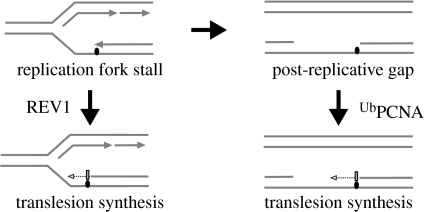Figure 3.
REV1 and PCNA ubiquitination define temporally distinct mechanisms for controlling translesion synthesis. On encountering a lesion (black oval) that blocks the replicative DNA polymerases, translesion synthesis can be directly recruited (dotted line), thereby allowing the fork to continue. This recruitment requires the C terminus of REV1. Alternatively, the fork can arrest and restart downstream of the template lesion leaving a gap. This gap is flagged by PCNA ubiquitination, which also facilitates the recruitment of translesion polymerases. We suggest that the former mechanism might be favoured on the leading strand, the latter on the lagging strand where discontinuous Okazaki fragment synthesis will lead more readily to gap formation.

